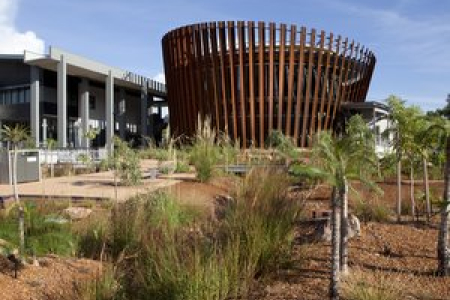Awards for Indigenous knowledges learning facility
The recently opened $30 million Australian Centre for Indigenous Knowledges and Education (ACIKE) at Charles Darwin University has received two commendations at the 2013 Engineering Excellence Awards.
DKJ.projects.architecture received a Commendation for Public Architecture and a Commendation for Interior Architecture for the design of the complex on Casuarina campus.
The project entailed the construction of four new buildings and one existing building refurbishment to meet the teaching and communication requirements of the ACIKE users.
Supported by the Australian Government, and opened by Prime Minister Julia Gillard, the collaborative venture between CDU and the Batchelor Institute for Indigenous Tertiary Education focuses on Indigenous higher education needs.
CDU Vice-Chancellor Professor Barney Glover said ACIKE was designed to increase the capacity of CDU and Batchelor Institute to facilitate positive outcomes in Indigenous communities and the Higher Education sector in areas relating to Indigenous knowledges and education.
“Teaching and research at ACIKE is multi-disciplinary including fields of Indigenous knowledges and other general disciplines such as nursing, education and arts at both undergraduate and postgraduate levels,” Professor Glover said.
“IT enabled literacy laboratories, shared teaching and Indigenous support and advisory spaces mean that lectures presented within the spaces are also capable of being transmitted to remote communities throughout the Territory.
“There is also a gallery showcasing Indigenous artworks, and office spaces for the co-location of Indigenous research groups, academics and teaching staff.”
The design of ACIKE aimed to focus on the Indigenous population and create a learning environment that respects and honours Indigenous people and their cultures.
For special events a ceremonial pit was built for traditional dancing. The space is also designed to honour male and female only spaces.
The building was commended for setting a change in Indigenous education, which recognises the strength of acknowledged cultural awareness within the built learning environment. The jury was also impressed with the importance of Indigenous links to the landscape, which has been well thought through in the riverine theme, both in the courtyard and in the water-gardens at the front of the project.
